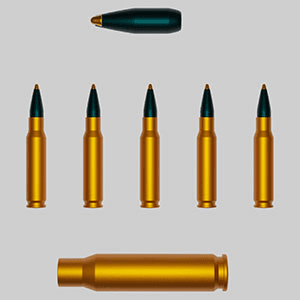The Of Ammunition Pro Llc
The Of Ammunition Pro Llc
Blog Article
Little Known Questions About Ammunition Pro Llc.
Table of ContentsEverything about Ammunition Pro LlcA Biased View of Ammunition Pro LlcSome Ideas on Ammunition Pro Llc You Need To KnowAmmunition Pro Llc for DummiesThe Facts About Ammunition Pro Llc Uncovered
The basic parts of ammunition are the same for rifle, pistol, and shotgun ammunition. Knowing just how ammo functions is a vital aspect in being a liable gun proprietor. Today we're considering the what the fundamental parts of ammo are and just how they interact to terminate a round. The fundamental parts of ammo revealed on a 9mm. Shooting Supplies round.The bullet is seated in the open end of the case. When you terminate a bullet out of a semi-auto weapon, the weapon's extractor raises the case from the shooting chamber and it flies out of the weapon.
A weapon's shooting pin strikes a cartridge's guide. The guide is a metal mug that holds an explosive chemical substance. When the firing pin strikes the guide cap, it squashes the priming substance against the anvil. This produces a little explosion in case that stirs up the propellant. The primer lies in the rim of the instance of a rimfire cartridge.
The 3-Minute Rule for Ammunition Pro Llc
Both usual types of primers in centerfire cartridges are Berdan and Fighter primers. Gunpowder alongside the situation that typically has it. Powder, additionally called propellant or gunpowder, is a fast-burning chemical blend. The guide explosion sparks it. It is normally a blend of saltpeter, charcoal, and sulfur.

We call the projectiles for shotshells, which we discharge through shotguns, slugs and shot. Now that you have a standard understanding of the standard components of ammo, you can really feel a little a lot more certain in just how your weapon and ammo feature!.
Ammunition Pro Llc Things To Know Before You Buy
Stay up to date with Special Deals, Advancement Notification of Sales, and Store Occasions
Fun truth: Grains are utilized to describe the mass of a bullet because completely back in the early days of guns, it was an apothecary's device of dimension, and an usual step was required to figure out exactly how much result in use to make cast lead bullets (Ammo Retailer). 'Grains' as a system of step for weight copulates back to ancient times, and stands for the weight of a grain of wheat

(https://www.giantbomb.com/profile/ammunitiondde/)For referral, the weight of a paper clip is around 16 gr. We know that grains are a procedure of mass, and extra = heavier, and heavy is great? Yes, heavy is great, however mass of the projectile isn't the only point you require to take into consideration when choosing a round for your weapon.
An Unbiased View of Ammunition Pro Llc
This spin is produced by grooves reduced or hammered right into the inside of the barrel, which are referred to as 'rifling'. Fun fact, this is the beginning of the term "Rifle" ex. A rifled musket vs. smoothbore musket. The impact this spin has on projectiles is a stabilizing one the bullet rotating keeps the nose aimed directly, in the exact same way that a completely spiraled football toss is mosting likely to be far more steady and accurate in trip than an awful duck, end over end throw.
Exactly how does this connect to grain weight? Imagine you're on one of those play ground carousels, the ones with bars you hold on to while it rotates.
The very same impact happens with bullets. The much heavier the projectile, the more impact a quicker spin will certainly have on it.
Ammunition Pro Llc for Dummies
Yet there's an additional variable that we have to think about when selecting a grain weight for our ammunition. As meant above, bullet rate, or the speed of the projectile, is a major element when establishing the very best grain weight projectile to use. Velocity is affected by a couple of significant aspects, including the type and quantity of propellant (gunpowder), barrel size, and bullet weight.

The most usual grain weight rounds for 9x19mm cartridges are 115gr and 124gr. These are typically lead core, fully jacketed (FMJ) rounds. Both of these grain weight cartridges will do well in factory 9mm handguns, to normal pistol ranges (up to 50 yards). 115 grain rounds are the most common (and for that reason least costly).
Report this page